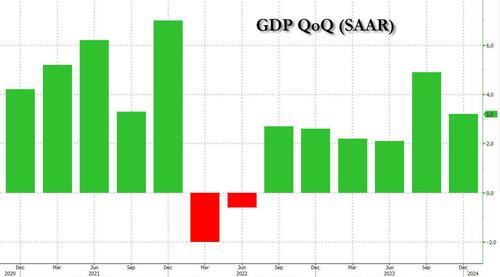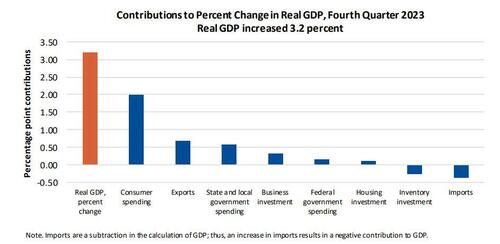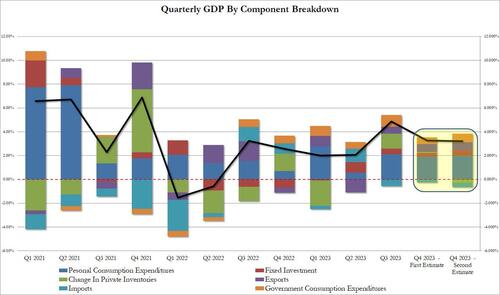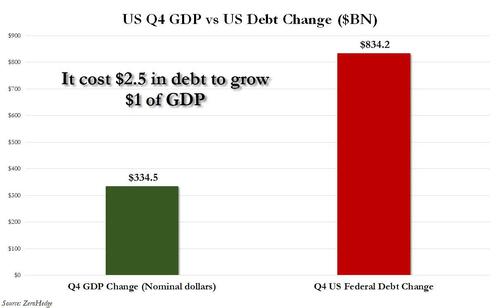First, according to the Biden admin, in Q4 GDP rose 3.2%, a modest drop from the 3.3% reported in the first estimate one month ago, and below the 3.3% consensus estimate.

While we already know this, the BEA reported that the increase in the fourth quarter primarily reflected increases in consumer spending, exports, and state and local government spending. Imports, which are a subtraction in the calculation of GDP, increased.
- The increase in consumer spending reflected increases in both services and goods. Within services, the leading contributors were health care, food services and accommodations, and other services (led by international travel). Within goods, the leading contributors to the increase were other nondurable goods (led by pharmaceutical products) as well as recreational goods and vehicles.
- The increase in exports reflected increases in both goods (led by petroleum) and services (led by financial services).
- The increase in state and local government spending reflected increases in both investment (led by structures) and consumption expenditures (led by compensation of employees).

Comparing the first estimate with the second, we find several notable items, the first being that Personal Consumption actually rose more than expected, growing a 3.0% QoQ annualized (vs 2.8% in the first estimate), and contributing 2.0% to the bottom line GDP of 3.21%, up from 1.91% in the original estimate. Another increase was seen in fixed investment which contributed 0.43% to the bottom line, up from the 0.31% originally estimated; finally government also saw its contribution boosted, rising to 0.73%, or about a quarter, of the final GDP. These improvement were offset by a notable drop in the change in private inventories which declined from an addition of 0.07% to a subtraction of -0.27%.

Ok, none of this matters: the numbers will be revised again next month but by then all markets will care about will be not so much Q1 GDP but rather Q2 and onward. So very stale.
But what does that have to do with the bitcoin spike?
Well, a closer look at the data revealed something stunning: a quick look at the increase in nominal GDP, which rose from $27.61 trillion in Q3 to $27.94 trillion in Q4, shows that the US economy increased some $334.5 billion in absolute nominal dollar terms.
But where did this growth come from? Why debt of course, and a lot of it. For the answer how much debt, we go to the US Treasury’s Debt to the penny website, where we find that debt on Sept 30, 2023 was $33,167,334,044,723.16 and debt on Dec 31, 2023 was $34,001,493,655,565.48.
In other words, it cost $834.2 billion in debt during Q3 to grow the US economy by $334.5 billion, or exactly $2.5 in debt for every $1 in GDP “growth.”

Which also brings us back full circle and explains why bitcoin is now trading at $60,000, the highest price since late 2021 and why it will not only surpass its all time high in just a few days, but why it will rise much, much higher, because the US is now well past the point of no return.






Hi colleagues, how is the whole thing, and what you desire to say on the topic of this paragraph, in my view its really awesome for me.
gamefly https://tinyurl.com/235hnz7u
Your mode of describing all in this piece of writing is in fact fastidious, all
be capable of effortlessly be aware of it, Thanks a lot.
Review my page :: vpn
Nice blog here! Also your website loads up very fast!
What web host are you using? Can I get your affiliate link
to your host? I wish my web site loaded up as fast as
yours lol
my webpage Eharmony special Coupon code 2025
350fairfax nordvpn coupon code
Pretty! This has been an extremely wonderful post. Thanks for providing this info.
Hi there! Do you know if they make any plugins to safeguard against hackers?
I’m kinda paranoid about losing everything I’ve worked
hard on. Any tips?
My blog post :: nordvpn coupons inspiresensation – https://t.co/ –
Keep this going please, great job!
My web page; Nordvpn coupons Inspiresensation
Greetings I am so grateful I found your website, I really found you by mistake, while I was looking on Google for something else, Anyhow I am here
now and would just like to say many thanks for a incredible post and
a all round thrilling blog (I also love the theme/design), I don’t
have time to go through it all at the moment but I
have saved it and also included your RSS feeds, so when I have
time I will be back to read a lot more, Please do keep up the excellent work.
Feel free to visit my webpage: nordvpn coupons inspiresensation (cfg.me)
Oh my goodness! Incredible article dude! Thanks, However I
am experiencing problems with your RSS. I don’t understand the reason why I cannot subscribe to it.
Is there anybody having the same RSS issues? Anyone who knows the solution can you kindly respond?
Thanks!!
my web page :: nordvpn coupons inspiresensation
Hey there You have done a fantastic job I will certainly digg it and personally recommend to my friends Im confident theyll be benefited from this site
Hello, World!
Hey there, mate! Greetings from your favorite surfing capybara!
How’s the surf today?
Ready to catch some gnarly waves together?
https://capybara888.wordpress.com/
Good luck!